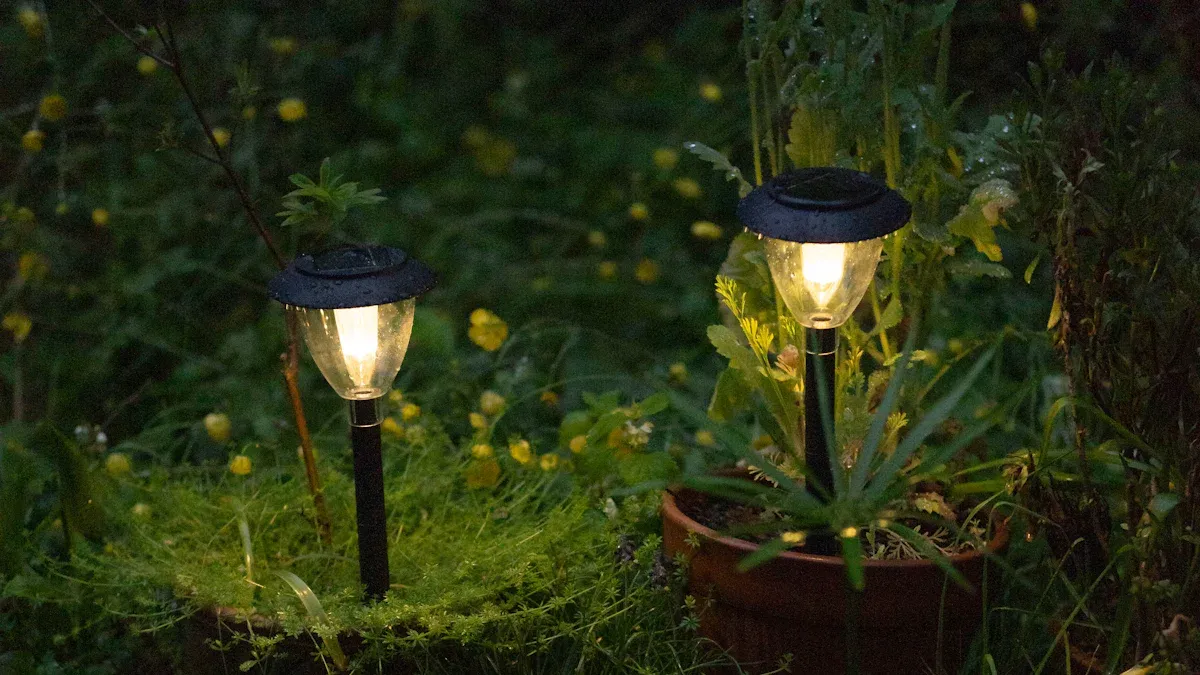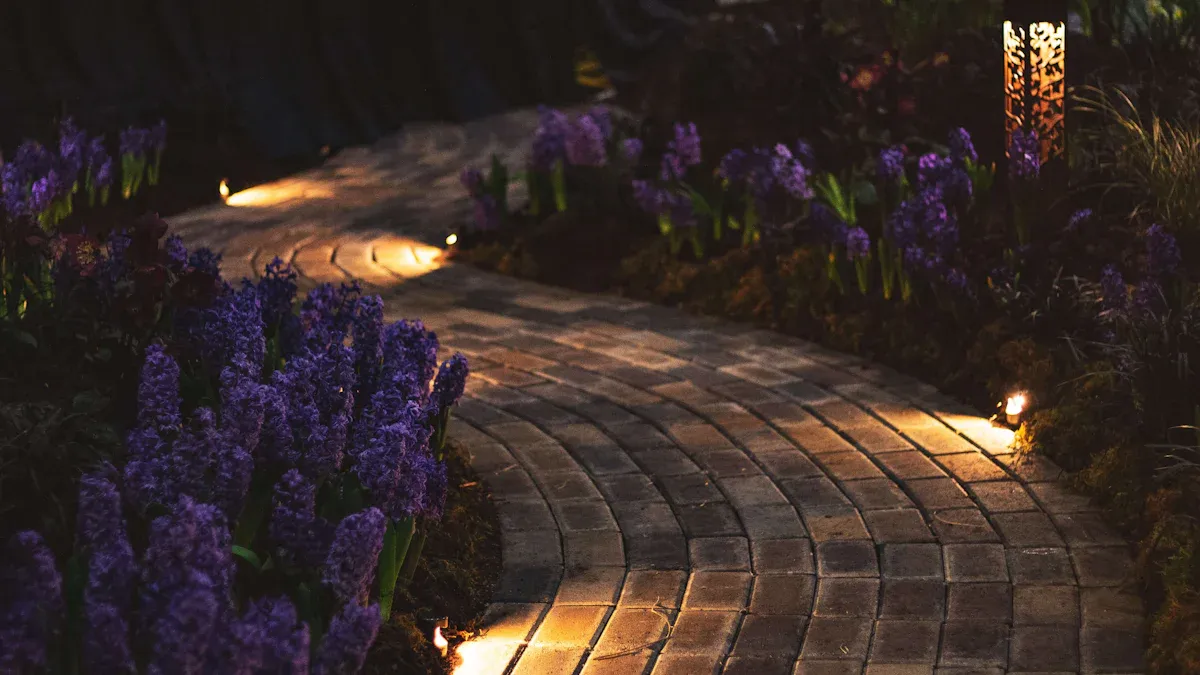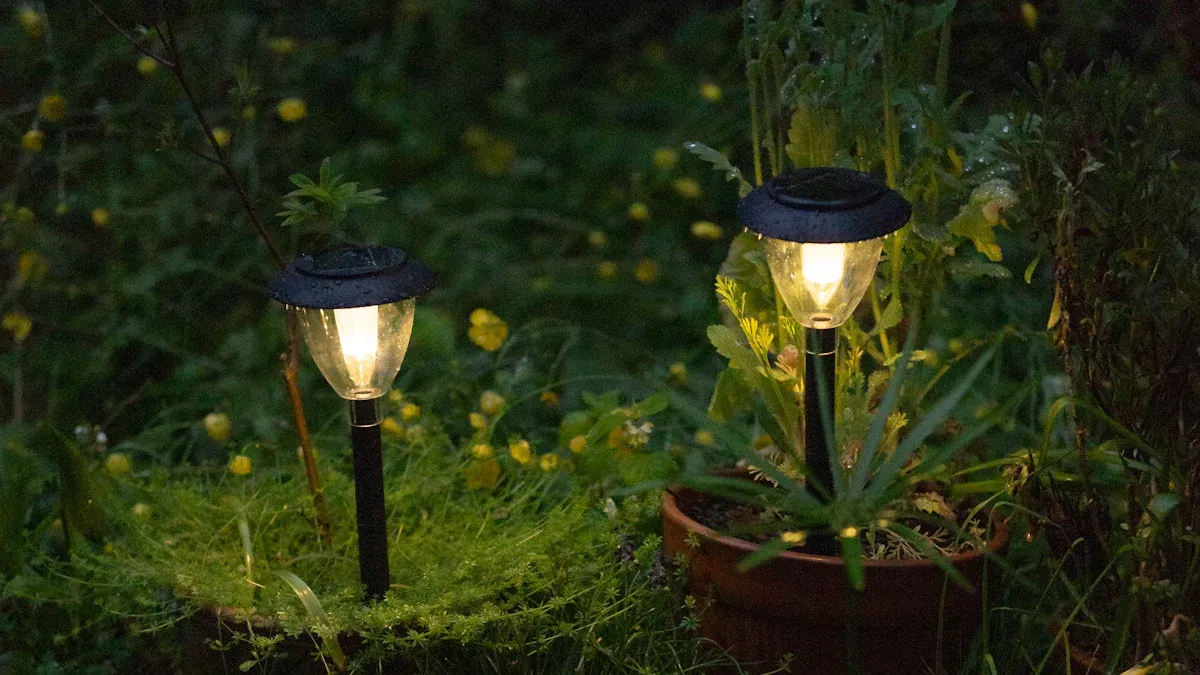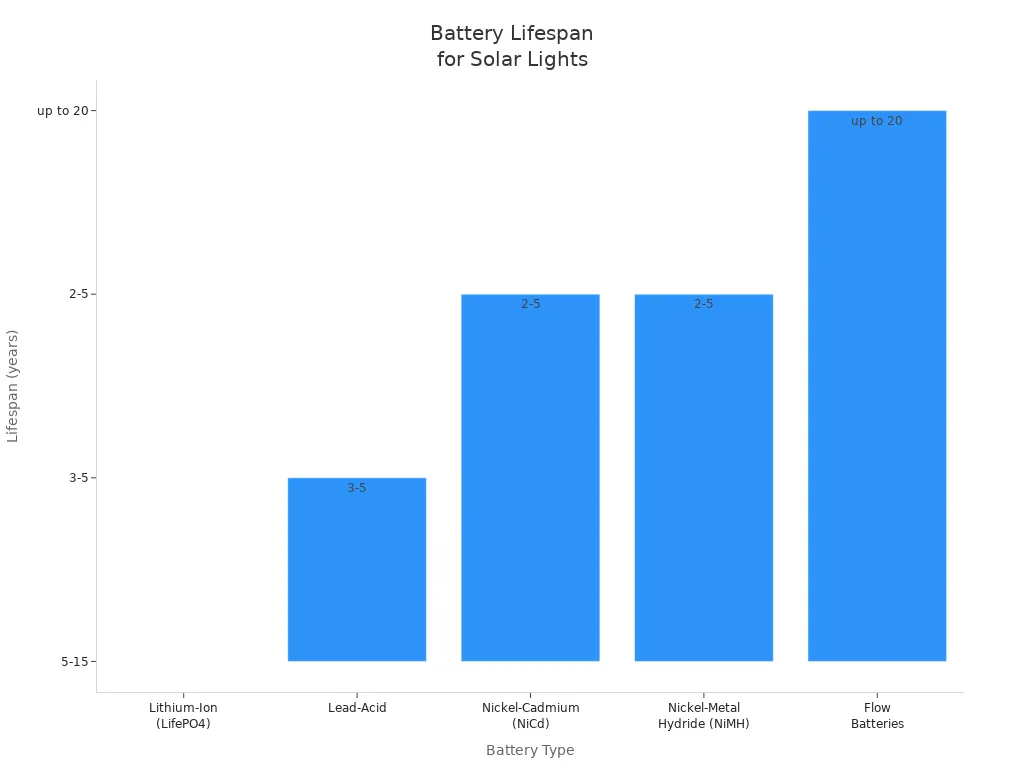
You want your yard to shine at night without wasting energy or money. Switching to solar light can save about $15.60 per light each year, thanks to lower power bills and less upkeep.
| Annual Savings per Light | About $15.60 |
|---|
Try options like the X Auto Brightness Adjustment Light or X High Lumen Solar Light for even more control and brightness.
Key Takeaways
- Solar lights save energy and money by using sunlight, and they are easy to install without wiring or special tools.
- Choose solar lights based on brightness, battery life, weather resistance, and special features like motion sensors to fit your yard's needs.
- Place solar lights where they get at least six hours of direct sunlight, clean the panels regularly, and check batteries to keep them working well.
Why Choose Solar Light for Your Yard?

Energy Savings
You can save a lot of energy by switching to solar light in your yard. Each solar light uses the sun’s power, so you don’t pay for electricity. For example, one solar street light can save about 40 kWh of electricity every year compared to wired lights. That means you keep more money in your pocket and help the planet at the same time. Imagine if your whole neighborhood made the switch—those savings would really add up!
Easy Installation
You don’t need to be an electrician to set up solar lights. Most models just need you to stick them into the ground. No wires, no digging, and no need to call for help. You can finish the job in a single weekend. Wired lights, on the other hand, often need trenching and special tools. With solar, you get to enjoy your new lights faster and with less hassle.
Low Maintenance
Solar lights are simple to care for. You just need to clean the panels now and then, check the batteries every few months, and make sure the lights are working. Here’s a quick look at some common tasks:
| Task | How Often? |
|---|---|
| Clean solar panels | Every 2 months |
| Check batteries | Every 3-6 months |
| Replace batteries | Every 5-7 years |
Most of the time, you’ll spend just a few minutes keeping your lights in top shape.
Eco-Friendly Benefits
When you choose solar lights, you help the environment. These lights use renewable energy and don’t need power from the grid. You also avoid extra wiring and reduce waste. Many solar lights use recyclable batteries, which supports sustainability. Plus, new features like motion sensors and smart controls make them even more efficient and modern.
Types of Solar Light Compared

Pathway Solar Light
You want to keep your walkways safe and bright. Pathway solar lights sit low to the ground and line your garden paths or driveways. They help you see where you are going and stop trips or falls. Most pathway lights give off 50 to 200 lumens and last 6 to 10 hours after a sunny day. You can install them easily—just push them into the soil.
Tip: Clean the solar panels every few months to keep them shining bright!
Solar Spotlight
Solar spotlights help you show off your favorite tree, statue, or flower bed. These lights have focused beams and adjustable heads. You can point them right where you want. Some models reach up to 800 lumens, which is great for security or highlighting special features. You do not need wires, so you can move them around as your yard changes.
Solar String Light
Solar string lights add a cozy glow to patios, fences, or decks. You can hang them above your seating area or wrap them around railings. They work well for parties or quiet nights outside. Many people use them to decorate for holidays or special events. These lights are flexible and easy to install.
Decorative Solar Light
Decorative solar lights bring style to your yard. You can find lanterns, globes, or lights with fun patterns. They give off a soft, warm light and make your garden look magical. These lights focus more on looks than brightness, so they are perfect for adding charm.
Solar Flood Light
Solar flood lights cover large areas with bright light. They work well for driveways, garages, or dark corners. Most models shine between 700 and 1300 lumens. You can space them about 8 to 10 feet apart for the best coverage. These lights help keep your home safe at night.
Solar Wall Light
Solar wall lights mount on fences, walls, or near doors. You can use them for security or to light up entryways. Many have motion sensors and adjustable brightness. For security, look for models with 700 to 1300 lumens. For accent lighting, 100 to 200 lumens is enough. Make sure you pick weatherproof models for long-lasting use.
How to Compare and Choose Solar Light
Brightness (Lumens)
When you shop for outdoor lights, you’ll see the word “lumens” a lot. Lumens tell you how bright a light will look. But brightness isn’t just about the number on the box. Here’s what you need to know:
- Lumens measure the total visible light a lamp gives off. More lumens mean a brighter light.
- The design of the lamp, the angle of the beam, and the color temperature all change how bright the light feels.
- Cool white light (5000K–6500K) looks brighter than warm white (2700K–3000K), even if the lumens are the same.
- A narrow beam puts more light in one spot, while a wide beam spreads it out.
- Where you place the light and how much sunlight it gets also affect how bright it will seem at night.
Tip: Don’t just pick the highest lumens. Think about where you want the light and how you want your yard to look.
Battery Life and Charging Time
You want your lights to last all night, even after a cloudy day. Battery life and charging time matter a lot. Here’s a quick look at what you can expect from high-quality solar lights:
| Aspect | Details |
|---|---|
| Typical nightly runtime | 8 to 12 hours after a full charge |
| Battery lifespan | Lithium-Ion (LifePO4): 5 to 15 years Lead-Acid: 3 to 5 years NiCd/NiMH: 2 to 5 years Flow Batteries: up to 20 years |
| Battery capacity design | Supports 3 to 5 days of operation during cloudy or rainy weather |
| Charging time factors | Needs direct sunlight for best results |
| Maintenance | Clean panels and replace batteries as needed |

Note: Place your lights where they get the most sun. Clean the panels often to help them charge faster and last longer.
Weather Resistance and Durability
Outdoor lights face rain, snow, dust, and even the neighbor’s sprinkler. You need lights that can handle it all. Look for the IP (Ingress Protection) rating on the box. Here’s what those numbers mean:
- IP65: Dust-tight and can handle low-pressure water jets. Good for most yards.
- IP66: Protects against stronger water jets. Great if you get heavy rain.
- IP67: Can survive being under water for a short time (up to 1 meter for 30 minutes). Best for flood-prone spots.
All these ratings mean your lights can stand up to tough weather. If you want your lights to last, pick models with a high IP rating and sturdy materials like ABS plastic or stainless steel.
Installation and Placement
Setting up solar lights is usually easy, but you still need a plan. Here’s how you can get the best results:
- Pick spots that get at least 6-8 hours of direct sunlight. Avoid shade from trees, fences, or buildings.
- Clear away rocks, weeds, and debris. Loosen the soil if you’re putting lights in the ground.
- Mark where you want each light. Even spacing looks better and lights up your path or garden evenly.
- Put the lights together and place them firmly in the ground or on the wall.
- Turn them on and check them at night. Move them if you see dark spots or too much glare.
- Adjust settings like brightness or color modes if your lights have them.
- Keep your lights clean and check the batteries every few months.
Pro Tip: Tall plants can block low lights. Use spotlights or wall lights to shine over bushes and flowers.
Special Features (Motion Sensors, Color Modes, etc.)
Modern solar lights come with cool features that make your yard safer and more fun. Here are some of the most popular options:
- Motion sensors turn the light on only when someone walks by. This saves energy and adds security.
- Color-changing modes let you pick from millions of colors or set seasonal themes.
- Multiple lighting modes give you choices like steady light, motion-activated, or a mix of both.
- Some lights have app control, so you can change brightness or color from your phone.
- Weather resistance and long battery life are always a plus.
- High-efficiency solar panels charge faster and work better in less sunlight.
| Feature Type | Description | Value to Homeowners |
|---|---|---|
| Motion Sensors | Detect movement up to 30 feet, activate lights for security | Enhances safety and energy efficiency |
| Color-Changing Modes | RGB options with millions of hues, seasonal colors | Provides aesthetic versatility and ambiance control |
| Multiple Lighting Modes | Options like constant, motion-activated, hybrid modes | Offers convenience and tailored lighting |
| App Control | Adjust brightness, colors, and schedules remotely | Adds smart convenience and customization |
| Weather Resistance | IP65+ waterproof ratings, cold resistance | Ensures durability and reliable outdoor use |
| High-Efficiency Solar Panels | Mono-crystalline panels with 23%+ efficiency | Maximizes energy harvesting and battery life |
Note: If you want to save energy and boost security, go for lights with motion sensors and hybrid modes.
Budget Considerations
You don’t have to spend a fortune to get good lights. Prices vary by type and features. Here’s a quick guide to what you might pay for high-quality options:
| Category | Price Range (USD) |
|---|---|
| Motion Sensor Outdoor Floodlights | $20 - $37 |
| Outdoor Solar Stake Lights | $23 - $40 |
| Ambient Solar Lights | Around $60 |
Think about what you need most—brightness, special features, or style. Sometimes, spending a little more means you get a light that lasts longer and works better.
Remember: The best solar light for your yard is the one that fits your needs and your budget.
Common Mistakes When Choosing Solar Light
Overlooking Sunlight Exposure
You might think any spot in your yard will work, but sunlight matters a lot. If you put your lights in the shade, they won’t get enough energy. Trees, fences, or even your house can block the sun. When that happens, your lights may glow dimly or not turn on at all. Dirt on the panels and changes in the seasons also make a difference. Always pick places that get at least six hours of direct sunlight each day. Clean the panels often and check for anything that might block the sun. This way, your lights will shine bright all night.
Ignoring Weatherproof Ratings
Not all outdoor lights can handle rain, dust, or snow. You need to check the IP rating before you buy. Here’s a quick guide:
| IP Rating | Protection Level | Best For | What Happens If Ignored |
|---|---|---|---|
| IP65 | Dustproof, water-jet proof | Mild outdoor areas | Water or dust can get in, causing damage |
| IP66 | Strong water jet resistance | Harsh weather | More failures and safety risks |
| IP67 | Short-term immersion | Flood-prone or dusty places | Frequent breakdowns and repairs |
| IP68 | Long-term immersion | Very wet or muddy environments | Short circuits and mold problems |
If you skip this step, you might end up with broken lights and extra costs.
Choosing the Wrong Brightness
It’s easy to pick lights that are too dim or too bright. If you choose lights that are not bright enough, your yard will look dull and unsafe. If you go too bright, you might get glare or bother your neighbors. Think about where you want the light and how much you need. Pathways need less light than driveways or entryways. Always check the lumens on the box and match them to your space.
Skipping Product Reviews
You might want to grab the first light you see, but reviews can save you trouble. Other buyers share real stories about how the lights work in different weather, how long they last, and if they are easy to install. Reading reviews helps you avoid poor-quality products and find the best fit for your yard.
You have lots of choices for your yard. Think about brightness, style, and where you want each light. Set your budget before you shop. Pick features that match your needs. With the right plan, you can create a yard that feels safe and looks great.
FAQ
How long do solar lights last at night?
Most solar lights glow for 8 to 12 hours after a sunny day. Cloudy weather or dirty panels can make them run shorter.
Can you leave solar lights outside all year?
Yes, you can. Just pick lights with a high IP rating. Clean snow or dirt off the panels for best results.
Do solar lights work in winter?
Solar lights still work in winter. Shorter days and less sun mean they might not shine as long. Place them where they get the most sunlight.
Post time: Aug-03-2025
